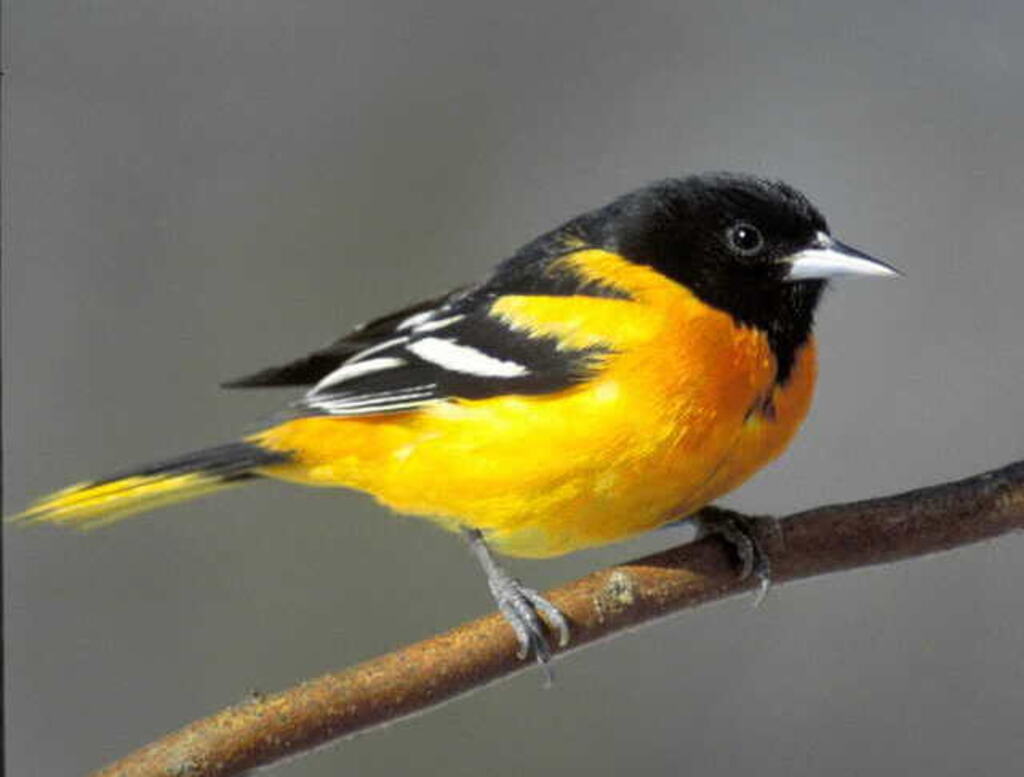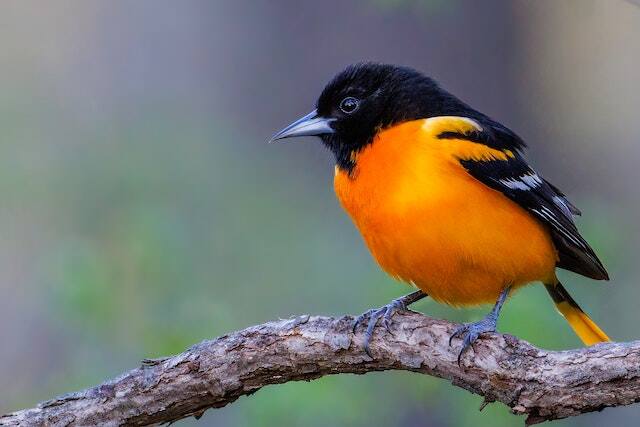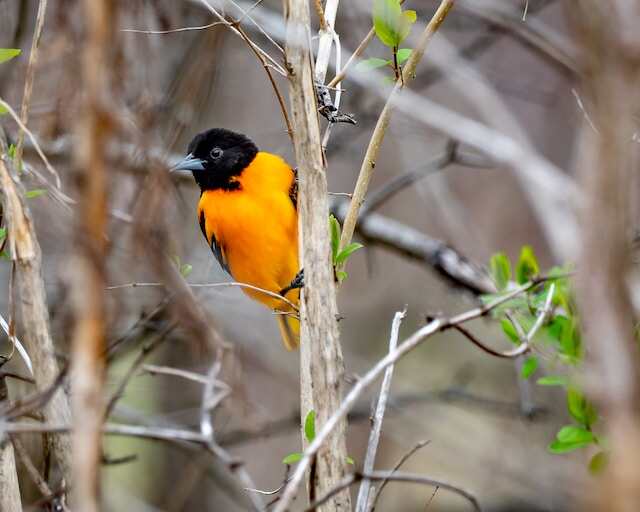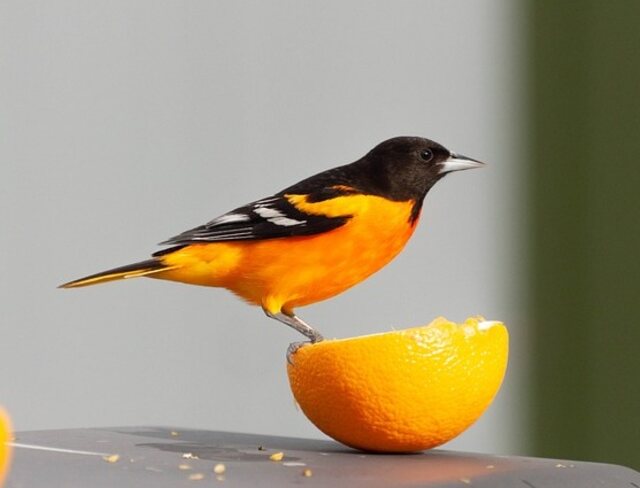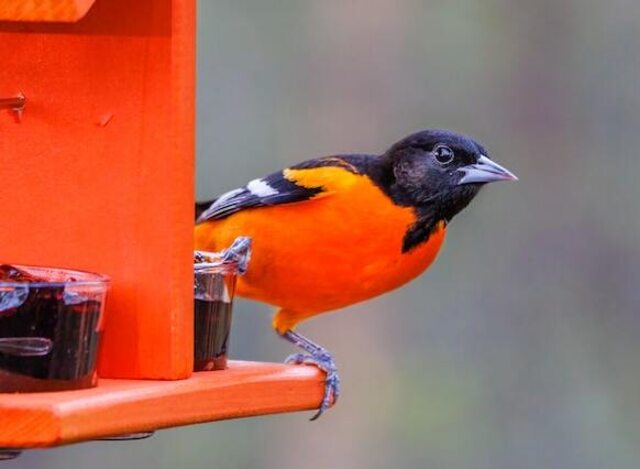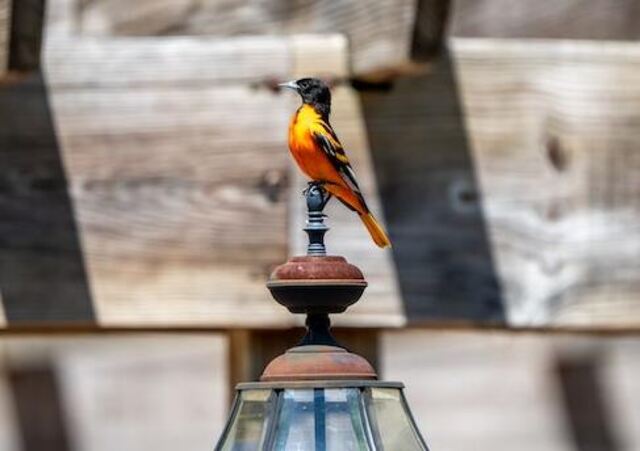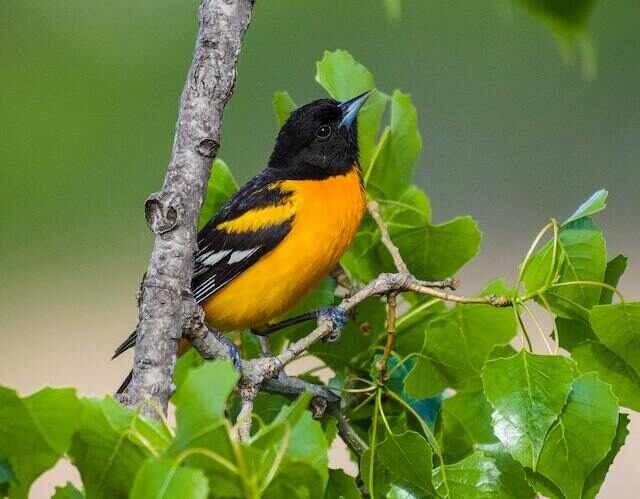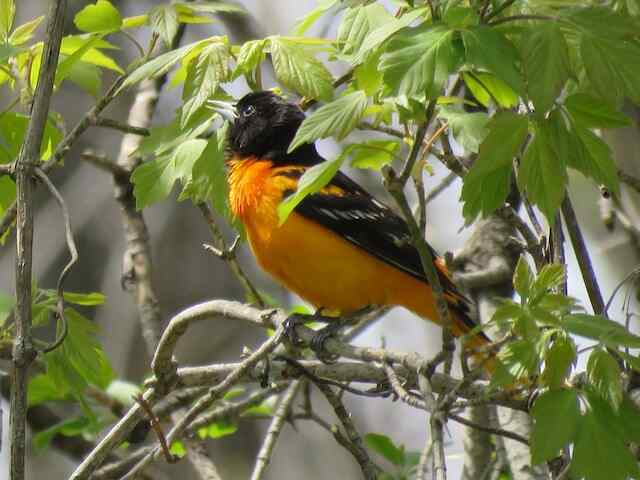Do Baltimore Orioles Eat from Hummingbird Feeders? You may be surprised to learn that the answer is a definite yes! But don’t fret, there are ways to appease both birds.
In this article, we’ll explore the reasons behind these feathered guests’ thievery and provide tips for living harmoniously with them. Ready to find out if Baltimore Orioles eat from hummingbird feeders? Read on!
Table of Contents
- 1 Baltimore Orioles and Hummingbird Feeders
- 2 Understanding the Differences Between Hummingbird and Oriole Feeders
- 3 Creating an Oriole Feeding Station: Tips for Attracting Orioles to Your Yard
- 4 Oriole Feeding Preferences Chart
- 5 What Foods Do Orioles Eat?
- 6 Feeding Orioles Jelly: How to Feed Grape Jelly to Orioles
- 7 Nectar Plants for Northern and Southern Gardens
- 8 Baltimore Orioles Love Hummingbird Feeders Too!
- 9 FAQs: Do Baltimore Orioles Eat from Hummingbird Feeders?
- 9.1 Do Baltimore Orioles really eat from hummingbird feeders?
- 9.2 Why do Baltimore Orioles eat from hummingbird feeders?
- 9.3 Will offering oranges or grape jelly in an oriole feeder stop them from raiding the hummingbird feeder?
- 9.4 How can I identify if the bird eating from my hummingbird feeder is a Baltimore Oriole?
- 9.5 Is it harmful to Baltimore Orioles to eat from hummingbird feeders?
- 9.6 How can I prevent Baltimore Orioles from eating all the nectar from my hummingbird feeder?
- 9.7 How do I make nectar for oriole feeders at home?
- 9.8 What are the best times to put out oriole feeders in the season?
- 9.9 Can Baltimore Orioles eat seeds or insects instead of nectar?
- 9.10 How can I make my backyard more attractive to Baltimore Orioles?
- 10 Author
Baltimore Orioles and Hummingbird Feeders
Baltimore Orioles are nectar eaters and one of the many birds that birders love to attract to their feeders. These stunning birds have a bright orange plumage that makes them stand out in any backyard.
Many birders wonder if Baltimore Orioles eat from hummingbird feeders, and the answer is yes! Orioles also love to feed on the nectar found in feeding holes and shrubs.
In addition, they are known for building intricate nests in trees and bushes.
Hummingbird feeders can be modified by birders to accommodate Baltimore Orioles by adding larger perches and feeding ports.
These modifications make it easier for the birds to access the nectar inside the feeder without damaging it with their sharp beaks.
Bee guards can be added to prevent bees from stealing the nectar.
Oriole nests can also be provided nearby, as well as orange halves, to encourage nesting and provide additional food sources for these beautiful birds.
Offering alternative food sources such as oranges and suet feeders can also attract Baltimore Orioles away from hummingbird feeders, which is useful for birders who want to cater to both nectar eaters and suet lovers.
Orange halves can be placed on a platform feeder or nailed onto a tree trunk, while suet feeders with feeding holes provide a high-fat food source that these birds love and can be hung alongside hummingbird feeders with feeding ports.
When setting up a feeder for Baltimore Orioles, birders should consider their feeding habits.
These birds prefer open areas with plenty of sunlight, making gardens an ideal location to place the feeder for increased visibility.
Offering fresh nectar is essential, but birders can also attract orioles by providing orange halves, as these birds are attracted to the color orange.
Remember to change the nectar every few days to keep these beautiful birds coming back.
Understanding the Differences Between Hummingbird and Oriole Feeders
Hummingbirds and orioles are two of the most fascinating nectar eaters to watch in your gardens. They both have unique feeding preferences, with hummingbirds preferring nectar from feeders or tree blossoms, while orioles enjoy nectar feeders and orange halves.
It’s essential to understand the differences between their feeders to attract these beautiful birds to your backyard.
Hummingbird feeders, with their small ports and perches, are perfect for the tiny birds. These birds love nectar made from boiling sugar and water.
The high concentration of sugar in the nectar solution gives them the energy they need to fly all day.
If you want to attract other birds like the Baltimore Oriole, consider adding plants or tree blossoms to your yard. You can also shop for specialized feeders to cater to their needs.
On the other hand, oriole feeders are larger in capacity and have wider openings than hummingbird feeders.
Orioles prefer nectar with lower sugar concentrations than hummingbirds, as they tend to eat more insects and fruits.
In addition to nectar, oriole feeders have a larger surface area for jelly, fruits, and mealworms that orioles love to eat.
If you want to attract orioles to your garden, consider placing an orange feeder alongside your plants. You can find them at your local shop.
If you’re thinking of using an oriole feeder for hummingbirds in your garden, it’s essential to note that this may attract bees and wasps due to the larger openings.
Hummingbirds can’t compete with these aggressive insects, as they don’t have stingers like bees and wasps do.
Consider adding some orange plants to your garden to further attract orioles and discourage bees and wasps from the feeder.
To prevent bees and wasps from getting into your hummingbird feeder, you can use bee guards or ant moats.
Bee guards are small plastic caps that fit over the ports of your hummingbird feeder while still allowing access for hummingbirds.
Ant moats are small cups filled with water that sit above the feeder’s base; ants cannot swim across them.
If you want to attract Baltimore Orioles, consider planting orange flowers or hanging orange slices near your feeder.
Creating an Oriole Feeding Station: Tips for Attracting Orioles to Your Yard
Attracting orioles to your backyard can be a fun and rewarding experience. These bright orange birds are known for their beautiful songs and unique feeding habits, making them a popular choice for birdwatchers everywhere.
If you’re interested in attracting orioles to your yard, setting up a dedicated feeding station with hummingbird nectar is the best way to do it. Additionally, planting certain plants can also help attract these lovely birds.
There are a few things you’ll need to keep in mind to attract orioles to your backyard. Adding an orange bird feeder can help attract many birds, while planting orange flowers or fruit trees can also catch their attention.
Here are some tips for attracting orioles to your backyard:
- Choose the right location: Oriole feeders should be placed in a sunny location, away from other bird feeders and potential predators. This will help ensure that the orioles, along with many birds, feel safe and comfortable while they’re feeding on their favorite orange nectar. Consider placing the feeder near plants to provide additional cover for the birds.
- Offer a variety of foods at your bird feeder: Orioles love nectar, jelly, and fresh fruit, so offering these foods along with slices of orange can help entice them to visit. Make sure to use high-quality nectar and jelly that doesn’t contain any artificial colors or preservatives. Consider planting native plants in your yard to provide a natural food source for the birds as well.
- Use the right orange feeder: When choosing an oriole feeder, look for one that has perches and is easy to clean. It’s also important to choose a feeder with bee guards and ant moats to keep unwanted visitors away.
- Keep ants away: Ants can be a major problem, try using an ant moat filled with water around the base of your feeder.
The optimal time to set up your orange oriole feeders is during early spring, when the birds are returning from their wintering grounds in Central and South America. This is when the birds make their way back north, and you can attract them with nourishing food.
Creating an oriole feeding station can take some time and effort, but it’s well worth it if you’re looking for an exciting new way to enjoy nature in your own backyard.
By following these tips, you’ll be well on your way to attracting these beautiful birds and enjoying all that they have to offer, especially with the addition of orange slices to the feeding station.
Oriole Feeding Preferences Chart
Orioles are beautiful birds that bring joy to any backyard. However, if you want to attract these feathered friends to your yard, it’s important to understand their feeding preferences for orange slices.
Firstly, it’s essential to note that different oriole species have varying feeding preferences. For example, Baltimore Orioles prefer nectar feeders over other types of oriole feeders.
Meanwhile, Orchard Orioles tend to prefer jelly or fruit feeders. Orange is a color that is attractive to many orioles and can be used to decorate the feeder to attract them.
In general, though, all orioles enjoy eating fruits and insects. Fruits such as oranges, grapes, and berries are particularly popular among these birds.
You can slice the fruits in half and place them on a feeder for the birds to eat.
Insects are another favorite food source for orioles. These birds love mealworms and will happily feast on them if they’re available in your backyard.
You can offer live mealworms in a dish feeder or sprinkle dried mealworms over fruit slices.
It’s worth noting that providing a variety of food sources can attract more orioles to your yard.
By offering different types of feeders with various foods inside them, you’ll be able to cater to the diverse tastes of these birds.
To summarize:
- Different oriole species have varying feeding preferences.
- Baltimore Orioles prefer nectar feeders.
- Orchard Orioles tend to prefer jelly or fruit feeders.
- All orioles enjoy eating fruits and insects.
- Providing a variety of food sources can attract more orioles to your yard.
By following these tips and understanding the feeding preferences of different oriole species, you’ll be well on your way to attracting these beautiful birds into your backyard!
What Foods Do Orioles Eat?
Orioles are a beautiful species of birds that have captured the hearts of many bird enthusiasts. These birds have a diverse diet, which makes feeding them an exciting activity.
If you are wondering what foods to offer your feathered friends, this article will provide you with all the answers.
Orioles primarily feed on insects, fruit, and nectar. They are insectivorous birds that love to eat beetles, caterpillars, ants, and spiders. Orioles also enjoy eating fruits such as oranges, apples, bananas, and grapes.
If you want to attract orioles to your backyard feeder, offering grape jelly is one of the best ways to do so. Grape jelly is a favorite food among orioles because it provides them with high sugar content that they need for energy.
You can also offer mealworms as they are an excellent source of protein for these birds.
Another favorite food among orioles is oranges. Oranges provide these birds with essential vitamins and minerals that help boost their immune system.
To offer oranges to your feathered friends, slice them in half and place them on a feeder or skewer.
Feeding orioles requires offering a variety of foods to meet their nutritional needs. You can try different types of fruits such as watermelon and cantaloupe as well as other high-sugar foods like honey and jam.
When making oriole food at home, it’s essential to avoid using artificial sweeteners or preservatives as they can be harmful to these birds’ health. Instead, use natural ingredients like sugar water or fresh fruit juice.
In addition to providing food sources for these birds in summer months when they migrate north from Central America back up into Canada, it’s important to have an oriole feeder not only during breeding season but year-round!
Feeding Orioles Jelly: How to Feed Grape Jelly to Orioles
Grape jelly is a favorite food of the Baltimore oriole, and feeding them jelly is an excellent way to attract these beautiful birds to your backyard.
Orioles are migratory birds that travel long distances, and they need high-energy foods like grape jelly during their travels. In this section, we will discuss how to feed grape jelly to orioles.
To begin with, it’s essential to know that grape jelly should be offered in small amounts. Too much jelly can be harmful to the birds’ health and attract unwanted pests such as ants and wasps.
A shallow dish or specialized feeder designed for jelly is ideal for feeding orioles. The feeder should have a flat surface where the bird can perch while eating.
When offering grape jelly to orioles, ensure that it’s free from preservatives and additives. Natural fruit pectin provides sufficient thickness to the jelly without using artificial thickeners.
It’s also important to keep the dish clean by washing it regularly with hot water and soap.
Another thing you may want to consider when feeding orioles is making nectar for them.
Nectar is a mixture of sugar and water that provides energy for hummingbirds and other nectar-feeding birds such as orioles.
To make nectar for orioles, mix one part white granulated sugar with four parts boiling water, stir until dissolved, let cool before serving.
It’s worth noting that not all orioles eat grape jelly; some prefer fresh fruit like oranges, apples, bananas, grapes, cherries, strawberries as well as mealworms which are rich in protein.
If you’re unsure what type of food your local oriole population prefers, try offering different types of food in small quantities until you find out what they like best.
Nectar Plants for Northern and Southern Gardens
Attracting nectar eaters like Baltimore Orioles to your garden can be a great way to add some color and life to your yard.
While nectar feeders can provide birds with the sweet nectar they crave, planting native plants like tulip tree blossoms and shrubs can also help create a diverse and inviting habitat for birds to build their nests and feed in the spring.
One of the best ways to attract the Baltimore Orioles is by providing them with plenty of sweet nectar.
Nectar feeders are an excellent option for those who want to attract these beautiful birds, but it’s important to remember that they aren’t the only source of nectar available.
Native plants like tulip tree blossoms and shrubs can also provide birds with plenty of sweet nectar throughout the year.
In addition to providing food for birds, planting a variety of flowers, fruit trees, grape vines, or oriole feeder can also help create a diverse habitat that is perfect for nesting.
When choosing which plants to include in your garden, it’s important to consider both the needs of the birds you want to attract and your own personal preferences.
Some great options for northern gardens include:
- Tulip tree blossoms
- Redbud flowers
- Serviceberry blooms
- Wild cherry blossoms
For southern gardens, some excellent choices include:
- Honeysuckle blooms
- Trumpet vine flowers
- Bottlebrush blooms
- Passionflower vines
By planting a variety of different flowers, fruits, and trees in your garden, you’ll be able to create an inviting environment that is perfect for attracting all kinds of different bird species.
Whether you’re looking to attract Baltimore Orioles or any other type of bird, there are plenty of great options available that are sure to make your garden come alive in the springtime.
So if you’re looking for a fun and rewarding way to bring more life into your yard this spring, consider adding some nectar plants and an oriole feeder to your garden.
With a little bit of planning and effort, you’ll be able to create an environment that is perfect for attracting all kinds of different birds and pollinators.
Baltimore Orioles Love Hummingbird Feeders Too!
Attracting Baltimore Orioles to your yard can be a fun and rewarding experience. These beautiful birds are known for their bright orange plumage and sweet songs, making them a favorite among bird enthusiasts.
While many people assume that hummingbird feeders are only suitable for hummingbirds, Baltimore Orioles love them too!
By following the tips outlined in this post, you can create an Oriole feeding station that will attract these stunning birds to your yard.
Understanding the differences between Hummingbird and Oriole feeders is crucial when creating a feeding station.
Oriole feeders have larger ports and perches than hummingbird feeders, allowing the orioles to comfortably access the nectar inside.
It’s also important to note that Orioles prefer nectar with a lower sugar concentration than hummingbirds, so make sure to adjust your recipe accordingly.
To attract Orioles to your yard, it’s essential to offer them a variety of foods. In addition to nectar, Orioles enjoy fruits such as oranges and grapes, as well as insects like mealworms.
Creating an Oriole Feeding Preferences Chart can help you keep track of what foods they prefer.
Feeding jelly is another effective way to attract Baltimore Orioles. Grape jelly is their favorite flavor, so make sure to provide it in a shallow dish or specially designed jelly feeder.
Finally, planting nectar-rich flowers such as Bee Balm and Cardinal Flower or setting up an oriole feeder can provide another source of food for these beautiful birds.
By following these tips and incorporating some creative strategies into your backyard birdwatching routine, you’ll be sure to attract Baltimore Orioles in no time!
FAQs: Do Baltimore Orioles Eat from Hummingbird Feeders?
Do Baltimore Orioles really eat from hummingbird feeders?
Yes, they do. Baltimore Orioles, being nectar-loving birds, are known to raid hummingbird feeders for the sweet nectar.
Why do Baltimore Orioles eat from hummingbird feeders?
Baltimore Orioles prefer sugary nectar as their primary diet. As a result, they are naturally attracted to hummingbird feeders containing a sweet nectar solution.
Will offering oranges or grape jelly in an oriole feeder stop them from raiding the hummingbird feeder?
Yes, offering oranges or grape jelly specifically in an oriole feeder can certainly attract them and draw their attention away from the hummingbird feeder.
How can I identify if the bird eating from my hummingbird feeder is a Baltimore Oriole?
Baltimore Orioles have a unique flame-orange color that makes them easy to identify. They also have a distinct pattern of black and white stripes on their wings.
Is it harmful to Baltimore Orioles to eat from hummingbird feeders?
No, it’s not harmful to orioles to consume nectar from hummingbird feeders. However, make sure to avoid offering orioles a solution that contains red dye, which can be harmful to the birds.
How can I prevent Baltimore Orioles from eating all the nectar from my hummingbird feeder?
One effective method is to set up a separate oriole feeder containing oranges or grape jelly. This can draw their attention away from the hummingbird feeder.
How do I make nectar for oriole feeders at home?
A simple recipe involves mixing four parts water with one-part sugar, boiled for approximately four minutes and allowed to cool before serving.
What are the best times to put out oriole feeders in the season?
The optimal time to set up your oriole feeders is during early spring when the birds return from their wintering grounds in Central and South America.
Can Baltimore Orioles eat seeds or insects instead of nectar?
Yes, Baltimore Orioles also feed on insects, fruit, and berries, in addition to nectar.
How can I make my backyard more attractive to Baltimore Orioles?
In addition to offering oranges or jelly in oriole feeders, you can plant fruit trees such as cherries or offer ripe fruit such as apples to attract them

